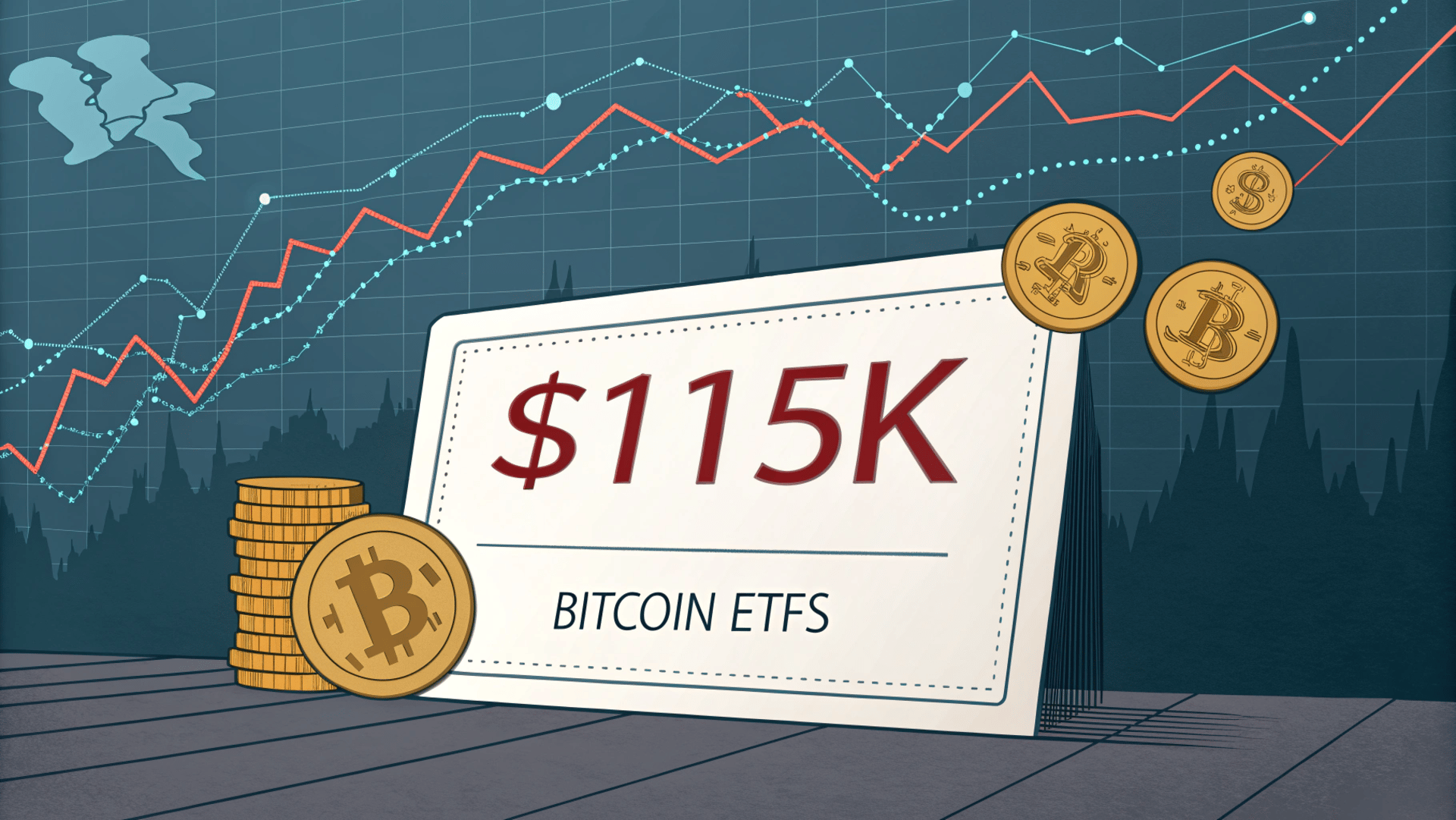- Unhashed Newsletter
- Posts
- $115K under threat, Bitcoin ETFs step in
$115K under threat, Bitcoin ETFs step in

Reading time: 5 minutes
Bitcoin wavers at $115K as holders sell, ETFs absorb flows

Key points:
Bitcoin slipped to $114,770, struggling to hold $115,000 support as holder distribution and whale sell-offs pressured momentum.
U.S. spot Bitcoin ETFs drew $2.3 billion in weekly inflows, signaling strong institutional demand despite short-term selling.
News - Bitcoin’s battle at the $115,000 mark has intensified, with the asset briefly dipping to $114,770 as selling pressure grew.
On-chain data showed all wallet cohorts, from small holders to whales, shifting back to distribution mode. A notable eight-year holder moved 1,176 BTC ($136M) to Hyperliquid, adding to concerns that profit-taking is outweighing fresh accumulation.
Technically, the Relative Strength Index (RSI) softened from bullish territory, hinting at fading momentum. If bearish sentiment persists, Bitcoin risks retesting $112,500, while a rebound above $115,000 could revive confidence and set the stage for $117,261 in the near term.
ETF demand counters weak hands - In contrast to on-chain selling, institutional appetite remains strong. Spot Bitcoin ETFs in the U.S. attracted $2.3 billion in inflows last week, led by BlackRock’s IBIT and Fidelity’s FBTC.
Analysts said the flows reflect structural demand, with expectations of a Federal Reserve rate cut this week providing an additional tailwind.
Macro divide: Recession risk vs AI-driven growth - Macro debates continue to shape sentiment. Moody’s warned of a 48% chance of a U.S. recession within 12 months, citing fragile growth, while Global Macro Investor’s Julien Bittel Visser argued that “the only trades that matter now are AI and crypto.” This contrast highlights how macro narratives, from recession risks to AI-driven growth, are increasingly influencing Bitcoin’s market outlook.
Outlook - Traders are eyeing the Fed’s decision this week and Bitcoin’s ability to reclaim $115,000. A dovish policy stance, coupled with steady ETF inflows, could propel BTC toward $118K–$120K, though persistent whale activity and cohort distribution remain key hurdles.
Solana’s bullish signal meets treasury boom

Key points:
Solana’s SuperTrend flashed a buy signal, historically followed by rallies of up to 3,200%, though a dip to $220 remains possible.
Institutional moves, including Helius’ $500M treasury and Galaxy’s $1.55B spree, have fueled inflows and strengthened adoption.
News - Solana (SOL) is navigating a mix of technical momentum and surging institutional interest. The token recently triggered a bullish SuperTrend buy signal on its weekly chart, an indicator that in past cycles preceded rallies of more than 600% to 3,200%.
While SOL rallied from August lows near $155 to touch $250, overbought conditions pushed the price back to $237. Analysts warn of a possible retest of the $230–$220 support zone before buyers attempt another breakout.
Despite the near-term pullback risk, the long-term setup remains constructive. Breaching resistance at $250–$260 could open the door to $295, with some traders eyeing targets as high as $1,000 if momentum mirrors prior cycles.
Treasury allocations drive demand - Institutional activity is providing a solid foundation. Nasdaq-listed Helius announced a $500M Solana treasury program backed by Pantera Capital, Summer Capital, and Animoca Brands. Shares of Helius soared over 200% following the news.
Meanwhile, Galaxy Digital has scooped up $1.55B worth of SOL in recent days, joining the broader wave of Solana-focused treasury firms.
ETPs mark record inflows - Solana products also led the $3.3B rebound in global crypto investment products last week, recording their biggest single-day inflow of $145M and a $198M weekly total. The surge highlights growing investor appetite for Solana exposure, particularly as its DeFi Total Value Locked (TVL) recently hit a record $12B, second only to Ethereum.
Outlook - SOL’s immediate path may involve a short-term reset, but structural demand from treasuries and ETPs continues to underpin its bullish case. Holding above $220 keeps the rally alive, with traders targeting $284–$300 in the next leg.
Ethereum Foundation bets on AI, but Buterin stays wary

Key points:
The Ethereum Foundation launched a new dAI team to integrate AI with blockchain payments and standards like ERC-8004.
Vitalik Buterin warned against AI-driven governance, citing risks of exploits and advocating for alternative models.
News - The Ethereum Foundation (EF) has unveiled a dedicated dAI team aimed at positioning Ethereum as the base layer for the machine economy. Announced by EF research scientist Davide Crapis, the initiative will focus on enabling AI agents to transact without intermediaries and on developing decentralized AI infrastructure that avoids dependence on large corporate platforms.
Central to this vision is ERC-8004, a proposed standard designed to prove the identity and trustworthiness of AI agents. The team plans to present it at November’s Devconnect conference in Buenos Aires.
Crapis said Ethereum’s neutrality and verifiability make it a natural platform for AI systems, adding that “Ethereum makes AI more trustworthy, and AI makes Ethereum more useful.”
Buterin raises red flags - While the EF pushes forward, co-founder Vitalik Buterin has cautioned against the use of AI in governance. Responding to recent demonstrations of ChatGPT jailbreaks, he warned that naive “AI governance” could be easily exploited. Instead, he promoted an “info finance” model using prediction markets and diverse external models to reduce vulnerabilities.
Privacy joins the agenda - The AI initiative comes as the EF also launched a new privacy roadmap under its Privacy Stewards of Ethereum (PSE). The roadmap prioritizes scalable privacy tools across transactions, governance, and identity, with early efforts like PlasmaFold for private transfers and support for privacy-focused wallets.
Outlook - Ethereum’s pivot toward AI reflects its ambition to expand beyond finance into intelligent systems. Yet the contrast between EF’s optimism and Buterin’s caution underscores the delicate balance between innovation and security as the network evolves.
Monero’s biggest reorg triggers security debate, price holds up

Key points:
Monero underwent an 18-block reorganization that erased 36 minutes of history and invalidated 118 transactions, with the episode tied to Qubic’s outsized mining power.
Despite the rollback, XMR rallied toward a two-month high near $333 as the community weighed temporary DNS checkpoints against decentralization concerns.
News - Monero faced its deepest reorganization on record after an 18-block rollback invalidated 118 previously confirmed transactions and rewrote roughly 36 minutes of activity.
The event, which began around block height 3,499,659, was linked by observers to Qubic, a mining pool and AI-focused chain that amassed a dominant share of Monero’s hash power last month. Monitors described withheld or “selfish” mining that later released a longer chain, prompting nodes to switch to it under proof-of-work rules.
What happened - Independent trackers and community commentators said the hidden chain overtook the public one, forcing the network to discard 18 blocks. The scale shattered the informal norm that ten confirmations provide finality, with some exchanges and users indicating they will raise confirmation thresholds or pause acceptance of XMR until stability returns.
Mitigations under discussion - Developers and researchers floated temporary DNS checkpoints to prevent repeat reorganizations, though critics warned this would add centralization risk. Community voices also revisited longer-term ideas such as alternative consensus protections to reduce majority hash influence.
Market reaction - XMR proved resilient during and after the event. Price spiked to about $333 before easing toward the low $300s, while reported daily volume jumped roughly 78 percent to about $136 million.
Outlook - Monero’s technical resilience and privacy focus remain intact, but repeated reorganizations could erode confidence unless the community implements credible safeguards that preserve decentralization.
More stories from the crypto ecosystem
Bitcoin: What’s next as $421 mln in old coins move and miners sell?
World Liberty Financial – Explaining the ‘split’ in WLFI traders as governance vote goes live
Somnia price prediction – Should traders await a breakout after THIS consolidation pattern?
USDH arrives – Can Hyperliquid’s new stablecoin shake USDC’s $6B grip?
A Satoshi-era Bitcoin whale just bet $4B on Ethereum! Is this ETH’s best Q3 yet?
Did you know?
India may avoid full crypto regulation amid systemic risk concerns - A recent Indian government document shows that despite global trends, India is leaning toward partial oversight rather than comprehensive crypto laws, citing fears that full regulation could bring systemic risks.
Tether’s new U.S. stablecoin “USAT” to comply with the GENIUS Act - Tether announced plans to launch a U.S.-based stablecoin called USAT, aimed at U.S. residents and designed to comply with the GENIUS Act. It will be issued by Anchorage Digital Bank and led by former White House official Bo Hines.
LSEG launches blockchain-platform for private funds - The London Stock Exchange Group (LSEG) rolled out a new blockchain-based infrastructure platform for private funds and has already completed its first transaction on it.
Top 3 coins of the day
Mantle (MNT)

Key points:
MNT traded at $1.69, marking a 3.33% daily rise while staying firmly above its 9-day SMA at $1.50.
The DMI showed strong bullish control as +DI held well above -DI, with the ADX at 35 confirming trend strength.
What you should know:
Mantle continued its upward trajectory, closing the day at $1.69 after touching highs near $1.70. Price action remained above the 9-day SMA at $1.50, signaling sustained momentum. The DMI highlighted a robust trend, with buyers leading as +DI outpaced -DI, while an ADX reading of 35 reflected solid strength. Trading volume of nearly 213K supported the bullish structure, reinforcing active participation. Beyond technicals, external drivers added fuel: Mantle’s perpetual futures listing on Coinbase International in late August opened doors for institutional traders, while Bybit’s promotional campaigns and high-yield incentives spurred retail flows. Looking ahead, holding above $1.50 keeps MNT well positioned, with $1.80 as the next barrier and $2.00 as the key psychological milestone if momentum persists.
Monero (XMR)

Key points:
At the time of writing, XMR was trading at $303 after a 0.91% dip in the past 24 hours.
The Parabolic SAR stayed below the candles, while the MACD histogram showed strengthening bullish momentum alongside higher trading volumes.
What you should know:
Monero’s price movement showed resilience as it consolidated near $303 despite a minor pullback. The Parabolic SAR maintained its bullish positioning, signaling that upward momentum remains intact. Meanwhile, the MACD line stayed above the signal line, with the histogram expanding further in positive territory, confirming strong buying pressure. Rising trading volumes in recent sessions reinforced this trend, suggesting sustained market interest. On the catalyst front, confidence in XMR improved after the community mitigated risks tied to Qubic’s mining centralization attempts, restoring network trust. Additionally, capital rotation into privacy coins has fueled demand, with Monero benefitting from this altseason momentum. Traders should watch the $290 support zone and the $310–$315 resistance range, as a breakout or breakdown from these levels could define near-term direction.
Flare (FLR)

Key points:
At press time, FLR traded at $0.0234, reflecting a 1.80% daily decline despite recent bullish attempts.
The Awesome Oscillator turned green in recent sessions, while price tested the upper Bollinger Band near $0.0238.
What you should know:
Flare’s price pulled back slightly after its recent recovery, settling at $0.0234. The Awesome Oscillator stayed green, signaling renewed bullish momentum, while the price tested resistance at the upper Bollinger Band around $0.0238. The midline at $0.0217 remains the nearest support, with $0.0199 as a stronger downside level. Daily trading volume came in at 9.03M, showing steady market participation. On the fundamental side, Flare’s visibility has grown following its integration into Revolut’s Learn & Earn program, exposing the token to hundreds of thousands of new users across global markets. Meanwhile, Flare’s DeFi ecosystem has continued to expand, with Total Value Locked surpassing $150M and adoption via platforms like XRPFi boosting long-term utility. Sustaining momentum above $0.024 could confirm further upside, but traders should watch if volume can keep pace to avoid another consolidation phase.
How was today's newsletter? |